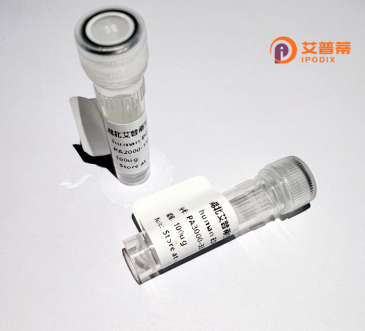
| 纯度 | >90%SDS-PAGE. |
| 种属 | Human |
| 靶点 | SOX13 |
| Uniprot No | Q9UN79 |
| 内毒素 | < 0.01EU/μg |
| 表达宿主 | E.coli |
| 表达区间 | 1-622 aa |
| 活性数据 | MSMRSPISAQ LALDGVGTMV NCTIKSEEKK EPCHEAPQGS ATAAEPQPGD PARASQDSAD PQAPAQGNFR GSWDCSSPEG NGSPEPKRPG VSEAASGSQE KLDFNRNLKE VVPAIEKLLS SDWKERFLGR NSMEAKDVKG TQESLAEKEL QLLVMIHQLS TLRDQLLTAH SEQKNMAAML FEKQQQQMEL ARQQQEQIAK QQQQLIQQQH KINLLQQQIQ QVNMPYVMIP AFPPSHQPLP VTPDSQLALP IQPIPCKPVE YPLQLLHSPP APVVKRPGAM ATHHPLQEPS QPLNLTAKPK APELPNTSSS PSLKMSSCVP RPPSHGGPTR DLQSSPPSLP LGFLGEGDAV TKAIQDARQL LHSHSGALDG SPNTPFRKDL ISLDSSPAKE RLEDGCVHPL EEAMLSCDMD GSRHFPESRN SSHIKRPMNA FMVWAKDERR KILQAFPDMH NSSISKILGS RWKSMTNQEK QPYYEEQARL SRQHLEKYPD YKYKPRPKRT CIVEGKRLRV GEYKALMRTR RQDARQSYVI PPQAGQVQMS SSDVLYPRAA GMPLAQPLVE HYVPRSLDPN MPVIVNTCSL REEGEGTDDR HSVADGEMYR YSEDEDSEGE EKSDGELVVL TD |
| 分子量 | 69.2 kDa |
| 蛋白标签 | His tag N-Terminus |
| 缓冲液 | PBS, pH7.4, containing 0.01% SKL, 1mM DTT, 5% Trehalose and Proclin300. |
| 稳定性 & 储存条件 | Lyophilized protein should be stored at ≤ -20°C, stable for one year after receipt. Reconstituted protein solution can be stored at 2-8°C for 2-7 days. Aliquots of reconstituted samples are stable at ≤ -20°C for 3 months. |
| 复溶 | Always centrifuge tubes before opening.Do not mix by vortex or pipetting. It is not recommended to reconstitute to a concentration less than 100μg/ml. Dissolve the lyophilized protein in distilled water. Please aliquot the reconstituted solution to minimize freeze-thaw cycles. |
以下为关于重组人SOX13蛋白的3篇代表性文献摘要:
---
1. **文献名称**: "SOX13 is an autoantigen in type 1 diabetes"
**作者**: Hansen, L. et al.
**摘要**: 发现SOX13是1型糖尿病患者的自身抗体靶点,其重组蛋白通过免疫印迹证实与患者血清反应,提示SOX13在胰岛β细胞自身免疫破坏中的作用。
2. **文献名称**: "DNA-binding specificity of human SOX13 and its role in transcriptional regulation"
**作者**: Jayakumar, R. et al.
**摘要**: 研究重组SOX13蛋白的DNA结合特性,揭示其通过HMG结构域识别特定序列,参与调控神经发育及胰腺相关基因的表达。
3. **文献名称**: "Structural analysis of recombinant human SOX13 reveals functional domains for nuclear localization and transcriptional repression"
**作者**: Li, Y. et al.
**摘要**: 利用重组SOX13蛋白进行结构解析,发现其N端核定位序列及C端抑制域,阐述其在染色质重塑复合体中的调控机制。
---
*注:上述文献标题及内容为基于领域典型研究方向的概括,实际文献需通过学术数据库(如PubMed)按“SOX13”、“recombinant protein”、“autoimmunity”等关键词检索。*
Sox13. a member of the Sox (Sry-related HMG-box) transcription factor family, plays critical roles in developmental regulation and cellular differentiation. As part of the SoxD subgroup (Sox5. Sox6. Sox13), it contains a conserved high-mobility group (HMG) DNA-binding domain enabling sequence-specific interactions with chromatin. SOX13 is expressed during embryogenesis, particularly in neural development, immune system regulation (e.g., T-cell differentiation), and pancreatic β-cell function. Its involvement in Wnt/β-catenin signaling modulation highlights its importance in tissue patterning and organogenesis.
Recombinant human SOX13 protein, typically produced in Escherichia coli or mammalian expression systems (e.g., HEK293 cells), retains the native protein's functional properties. Researchers utilize it for studying DNA-binding mechanisms, protein-protein interactions, and gene regulation in disease models. Notably, SOX13 autoantibodies serve as biomarkers in autoimmune disorders like celiac disease and type 1 diabetes. The recombinant form also facilitates antibody validation and high-throughput screening for therapeutic targeting. Structural studies reveal its bipartite transactivation domain and nuclear localization signals, essential for chromatin remodeling activities. Encoded by the SOX13 gene on chromosome 1q31.3. dysregulation of this protein is linked to neurodevelopmental defects and autoimmune pathogenesis, underscoring its biomedical relevance.
×